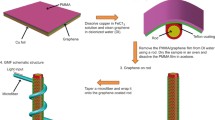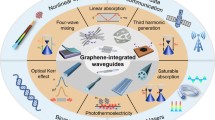Abstract
Graphene-microfiber with the advantage of graphene material and microfiber has been hailed as a wonderful optical waveguide. In this paper, its fabrication, optical properties and applications have been presented. Here, we present our recent progress in the graphene-microfiber waveguides from photonic devices, e.g., optical polarizers and optical modulators to mode-locking in fiber laser. With the novel nanotechnology emerging, graphene-microfiber could offer new possibilities for the future optic circuits, systems and networks.
Access provided by Autonomous University of Puebla. Download conference paper PDF
Similar content being viewed by others
Keywords
1 Introduction
Graphene has attracted significant attentions, due to a variety kind of excellent photonic and electronic properties [1]. Graphene, as two-dimensional (2D) hexagonal lattice forms of carbon, has been made as an ideal material for utilizing in the field of nano-electronics, devices and sensors. Because of its unique electronic structure and linear dispersion, the monolayer graphene has a constant absorption per unit mass of the semiconductor material (2.3%) across the visible and infrared range [2]. Compared to other optical materials, graphene has ultrafast carrier dynamics response over ultra-broad-band spectral range. The Pauli blocking effect enables it to exhibit many remarkable nonlinear optical properties such as saturable absorptions, high Kerr nonlinearity (nonlinear refractive index change), two-photon absorption, four-wave mixing (FWM) and so on. Furthermore, it can be controlled through electrical gating to shift the Fermi level for controlling the optical absorption. As an atomically thin film, it can also be flexible to integrate with the microfiber or other optical waveguides for wide applications on optical polarizers, modulators, mode-locked fiber lasers and so on.
Microfiber as one-dimensional (1D) micro/nano-scale waveguide with strong evanescent fields and ultra-tight optical confinement can effectively collect and launch the evanescent light to couple with other materials. In the microfiber, its large evanescent light enables strong or rapid near-field interaction with graphene, thus leading to so many potential applications. Here, we report our recent progress about the graphene-microfiber including its optical properties, fabrication and applications on photonic devices and lasers. We will start from the fundamentals of the graphene-microfiber, and then move to its applications. Finally, a brief outlook for opportunities and challenges of the graphene-microfiber in the future has been presented.
2 Fundamental of Graphene-Microfiber
2.1 Structure and Fabrication
To date, the structure of our designed graphene-microfiber is shown in Fig. 1, where the graphene film is tightly covered on the microfiber and the MgF2 substrate. The microfiber is fabricated by flame-heated taper-drawing technology [3] with the diameter down to micro/nano-scale. This technique could realize the tapering profile optimization and cross-section geometric control, and effectively decrease the propagation loss of the microfiber. Here, the fabrication process of the graphene-microfiber is in the following. The graphene film is grown on the surface of Cu or Ni by chemical vapor deposition (CVD) method, and then the low refractive index PMMA or ultraviolet glue is spin-coated on the graphene film surface. The polymer/graphene/metal sandwich structure is formed. To remove the metal layer, it can be soaked into the FeCl3 solution with a long time. Subsequently, the polymer-supported graphene washes in deionized water several times and covered on the microfiber with the MgF2 substrate. The PMMA or UV glue could be removed by acetone for our consideration. Then, we put it in a box to dry at room temperature for 12 h. Finally, the graphene-microfiber waveguide, as shown in Fig. 1, has been obtained.
2.2 Properties of Graphene Covered on the Microfiber
The dynamical conductivity σg of graphene should be considered in the Maxwell's equations for analyzing the effective refractive index of graphene and its optical field. The conductivity of graphene is related to radian frequency (ω), chemical potential (μc), the relaxation time (τ) and temperature (T), which is calculated from the Kubo formula:
where e is the charge of an electron, \(\hbar = h/2\pi\) is the reduced Planck’s constant, \(f_{d} \left( \varepsilon \right) = \left( {e^{{\left( {\varepsilon - \mu_{c} } \right)/k_{B} T}} + 1} \right)^{ - 1}\) is the Fermi–Dirac distribution and kB is Boltzmann’s constant. The first term in Eq. (1) is evaluated as the intraband conductivity, and the second is due to the interband contribution. The permittivity of the graphene is related to the conductivity as \(\varepsilon_{g} = \varepsilon_{0} - \sigma_{{{\text{g}},i}} /\omega d + j\sigma_{{{\text{g}},r}} /\omega d\) [4], where σg,i and σg,r are the imaginary and real part of the conductivity of graphene σg, d is the thickness of the graphene film and ω is the light's angular frequency. Figure 2 shows nonlinear saturable absorption of single-layer graphene measured by using picosecond pulse laser. Due to the graphene asymmetrically covered on the microfiber, when different polarized light pass through the graphene-microfiber, it presents polarization-dependence property on the nonlinear saturable absorption. This asymmetrical graphene-microfiber structure can be used as polarizer and modulator.
3 Applications of the Graphene-Microfiber
3.1 Photonic Devices Applications
Graphene-microfiber has broadband all-optical modulating, which can realize the modulation rate from 1 MHz [5] to 200 GHz [6]. Here, we use polarization-dependent graphene-microfiber structure to realize modulation [7] and polarization [8]. By changing the place of the core, a flexible graphene-microfiber polarizer can be obtained with high polarization extinction ratio of ~30 dB [8]. Because of the cross-absorption modulation effects of graphene [7], a 1480 nm pump light with a series of 100 Gbit/s RZ signals and 8-wavelength polarized continuous wave probe lights simultaneously come into the graphene-microfiber for generating 8 channel polarization-dependent modulated lights with 100Gbit/s RZ signals. X-polarized and Y-polarized modulated lights have different modulation depth of ~14.8 and ~14.88 dB. The modulation depth of the y-polarized light is larger than that of x-polarized. This means that such a modulator is remarkably suitable for the prominent application on digital community antenna television signal broadcast (Fig. 3).
Nonlinear saturable absorption of single-layer graphene [7]
3.2 Mode-Locked Fiber Laser Applications
In 2012, we used the reduced graphene oxides on the microfiber for passive mode-locking in Erbium-doped fiber laser to generate wide-band doublet pulses [9]. Subsequently, the chirped fiber grating can be introduced into the mode-locking fiber laser with graphene-microfiber. Wavelength-tunable pulses can be realized from 1550 to 1550 nm with pulse-width about 20 ps [10]. By tuning the polarization of the light propagated in the graphene-microfiber, pulse-width tunable pulses can be obtained in the fiber laser from ~9.24 to ~2.32 ps with 3 dB spectral bandwidth from ~6.03 to 26.32 nm [11], as shown in Fig. 4.
Output pulses and their 3 dB spectra [11]
4 Conclusion
Graphene-microfiber, as a novel fiber-based device not only can be used as saturable absorber in the fiber laser for mode-locking, but also can be opened up to new opportunities in photonic devices such as modulator, polarizer and so on. All these applications are due to the interaction between the strong evanescent optical field in the microfiber and the nonlinear saturable absorption with tunable chemical potential in the graphene. Except the above, graphene has another superior feature, e.g., large nonlinear Kerr effect, FWM, two-photonic absorption, electrically tuning the Fermi level and surface plasmon effect. When the graphene with these features is integrated with the microfiber, some new potential applications such as super-resolution imaging, optical sensor and so on can be realized.
References
Bonaccorso F, Sun Z, Hasan T, Ferrari AC (2010) Graphene photonics and optoelectronics. Nat Photon 4(9):611–622
Acouris P (2010) Graphene electronic and photonic properties and devices. Nano Lett 10(11):4285–4294
Tong L, Lou J, Mazur E (2004) Single-mode guiding properties of subwavelength-diameter silica and silicon wire waveguides. Opt Express 12(6):1025–1035
Wu Y, Yao B, Zhang A, Rao Y, Wang Z, Cheng Y, Gong Y, Zhang WL, Chen YF, Chiang KS (2014) Graphene-coated microfiber Bragg grating for high-sensitivity gas sensing. Opt Lett 39(5):1235–1237
Liu Z, Feng M, Jiang W, Xin W, Wang P, Sheng Q, Liu Y, Zhou W, Tian J (2013) Broadband all-optical modulation using a graphene microfiber. Laser Phys Lett 10(6):065901
Li W, Chen B, Meng C, Fang W, Xiao Y, Li X, Hu Z, Xu Y, Tong L, Wang H, Liu W, Bao J, Shen YR (2014) Ultrafast all-optical graphene modulator. Nano Lett 14(2):955–959
He X, Xu M, Zhang X (2016) Theoretical investigation of a broadband all-optical graphene-microfiber modulator. J Opt Soc Am B 33(12):2588–2595
He X, Liu J (2017) Flexible and broadband graphene polarizer based on surface silicon-core microfiber. Opt Mater Express 7(4):1398–1405
He X, Liu Z, Wang D, Yang M, Liao CR, Zhao X (2012) Passively mode-locked fiber lasers based on reduced graphene oxide microfiber for ultra-wide-band doublet pulse generation. J Lightwave Technol 30(7):984–989
He X, Liu Z, Wang D (2012) Wavelength-tunable, passively mode-locked fiber laser based on graphene and chirped fiber Bragg grating. Opt Lett 37(12):2394–2396
He X, Wang D, Liu Z (2014) Pulse-width tuning in a passively mode-locked fiber laser with graphene satruable absorber. IEEE Photon Technol Lett 26(4):360–363
Acknowledgements
The project is supported by National Natural Science Foundation of China (Number 61675046) and the Fundamental of Research Funds for the Center Universities (No. 2019PTB-006).
Author information
Authors and Affiliations
Corresponding author
Editor information
Editors and Affiliations
Rights and permissions
Copyright information
© 2021 Springer Nature Singapore Pte Ltd.
About this paper
Cite this paper
He, X., Hu, A., Guo, X., Li, C. (2021). Graphene-Microfiber and Its Application on Photonic Devices and Lasers. In: Xu, L., Zhou, L. (eds) Proceedings of the 8th International Multidisciplinary Conference on Optofluidics (IMCO 2018). IMCO 2018. Lecture Notes in Electrical Engineering, vol 531. Springer, Singapore. https://doi.org/10.1007/978-981-13-3381-1_5
Download citation
DOI: https://doi.org/10.1007/978-981-13-3381-1_5
Published:
Publisher Name: Springer, Singapore
Print ISBN: 978-981-13-3380-4
Online ISBN: 978-981-13-3381-1
eBook Packages: EngineeringEngineering (R0)








